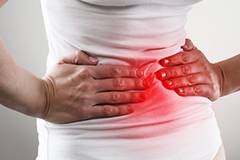Heavy Bleeding During Periods — When to Worry
Medically Reviewed by J. Michael Davidson, MD
Medically reviewed by Michael Davidson, MD McLeod Women’s Care
What’s “Normal” and What’s NOT
Generally, a woman’s menstrual period – when her body sheds the uterus lining – lasts 7 days. Bleeding can be captured with pads or tampons.
If the bleeding last more than 7 days and this occurs for several months, you may have a problem that needs medical attention. Other signs of irregularly heavy bleeding:
- Needing to change pads or tampons every 1-2 hours.
- Getting up in the middle of the night to change your pad or tampon.
- Finding blood clots the size of a quarter or larger on your pad or tampon.
- Feeling very tired or short of breath.
“Bleeding this heavy is called menorrhagia (men-uh-REEJ-yuh) and may have several causes,” says Gynecologist Dr. Michael Davidson of Advanced Women’s Care. “Heavy periods in teenagers are not uncommon and may settle down in time with or without treatment. They should be evaluated if bothersome, however, since treatments with medications are available.”
Causes
Heavy menstrual bleeding can be related to uterus problems, hormones or illnesses.
- Polyps, fibroids or endometriosis can cause abnormal uterine bleeding.
- There can be some bleeding in the early stages of pregnancy. This could be related to miscarriage or an ectopic pregnancy (when a fetus forms in the fallopian tubes rather than in the uterus).
- Chronic medical conditions – such as diabetes or disorders of the thyroid or adrenal gland – can cause bleeding.
- Sometimes medications can affect the body’s release of hormones, leading to bleeding.
Diagnosis
Your doctor will perform a physical exam, take some blood tests and may do a Pap smear. Based on the results, the following tests might be ordered:
- Ultrasound – similar to those used for pregnant women – gives an image of the pelvic organs.
- Endometrial biopsy involves taking a tissue sample from your uterus or surrounding area.
- Sonohysterogram (sahn-uh-HIS-ter-uh-gram) and a hysterosalpingogram (also known as an HSG) both involve injecting fluid through the cervix to better see the contours of the pelvic region.
- Hysteroscopy is a small tube inserted into the cervix through which the doctor can see the uterine cavity.
Treating the Problem
Before you call a doctor, here are some options to try:
- Take iron pills. Some studies suggest that low iron levels can increase menstrual bleeding. Also, heavy bleeding depletes the iron in your body, increasing fatigue.
- Try ice packs on your abdomen for 20 minutes several times a day.
- Try vitamin C to help your body absorb the iron.
Non-surgical treatments that your doctor may recommend to control bleeding and reduce pain include the use of medications – iron supplements, ibuprofen, birth control pills, and intrauterine contraception (IUD). The physician may also prescribe drugs that reduce bleeding by controlling blood clots. One such medicine, tranexamic acid tablets, can cut bleeding by 50%.
Minor surgical treatment can be part of a hysteroscopy. If the gynecologist finds polyps or small fibroids, these can be clipped and removed during the procedure. Other surgical treatments include:
- D&C (Dilation & Curettage) to remove the top layer of the uterus lining.
- Endometrial ablation vaporizes or freezes the tissues causing the problem.
- Myomectomy involves removing the fibroid from the uterus. This may sometimes be done laparoscopically.
- Hysterectomy involves surgically removing the uterus.
Pregnancy following treatment
With many treatments women can maintain their ability to get pregnant. Ablations result in reduced fertility, and after a hysterectomy, conceiving is impossible.
Sources include: McLeod Health, National Institutes of Health, American College of Obstetricians & Gynecologists, American Society for Reproductive Medicine, Centers for Disease Control & Prevention, HealthyWomen.org, Canadian Red Cross
-
McLEOD REGIONAL MEDICAL CENTER FLORENCE
843-777-2000 -
McLEOD DARLINGTON
843-777-1100 -
McLEOD DILLON
843-774-4111 -
McLEOD LORIS
843-716-7000 -
McLEOD SEACOAST
843-390-8100 -
McLEOD CHERAW
843-537-7881 -
McLEOD CLARENDON
803-433-3000



-
McLEOD REGIONAL MEDICAL CENTER FLORENCE
843-777-2000 -
McLEOD DARLINGTON
843-777-1100 -
McLEOD DILLON
843-774-4111 -
McLEOD LORIS
843-716-7000 -
McLEOD SEACOAST
843-390-8100 -
McLEOD CHERAW
843-537-7881 -
McLEOD CLARENDON
803-433-3000
 Find a Doctor
Find a Doctor  Locations
Locations  Services
Services 